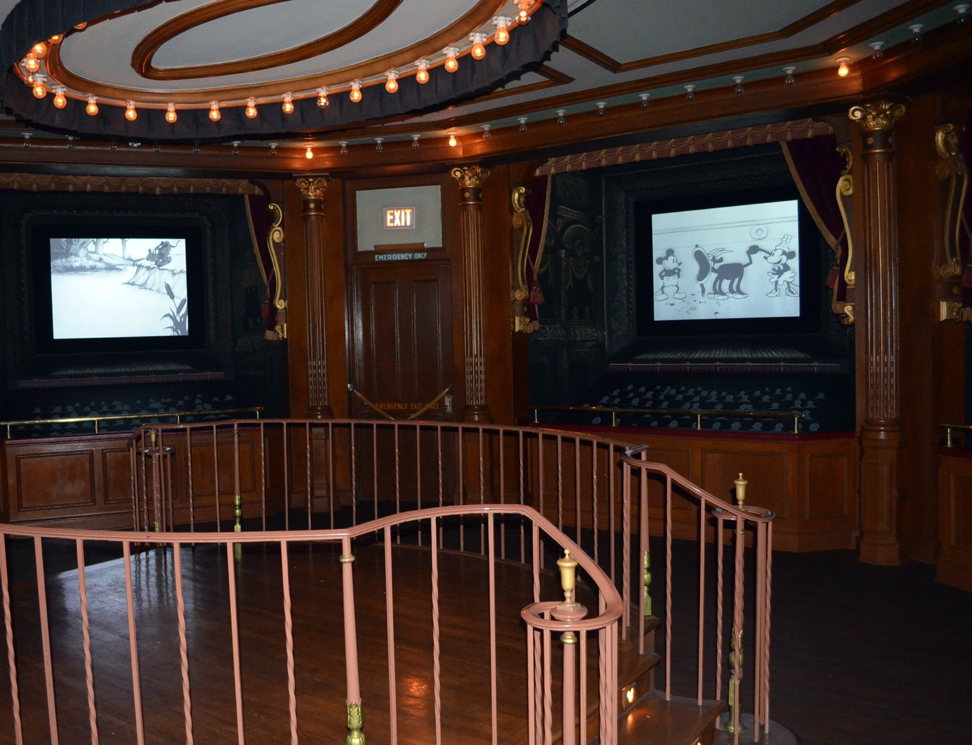
Steamboat Willie, the first fully synchronized animated film that also introduced Mickey and Minnie Mouse, was first publicly presented on November 18, 1928, at Universal’s Colony Theater in New York City. Unlike all other iterations of Disneyland around the world, the first, and only Magic Kingdom park created by Walt Disney, in Southern California still plays Steamboat Willie on a continuous loop from morning to night daily at the Cinema on Main Street (see Figure 1). The famed animated short is spotlighted on the cinema marquee along with a banner indicating that additional Disney cartoons are shown inside. To exhibit six classic cartoons, each with a separate soundtrack, in the compact space of the Cinema required Imagineers (i.e. the design and engineering arm of the Disney company) to decide on an optimal aural experience for park visitors.
The Main Street Cinema is an original Disneyland attraction dating from opening day on July 17, 1955. Inside the wood-paneled room of the Cinema, there are six screens each displaying a short film in a continuous loop all day long. In its first few decades, the Cinema offered live-action silent films that were period appropriate to the circa 1900 Main Street milieu including The Great Train Robbery (1903), Fatima’s Dance (year unknown), The Noise of Bombs (1914) with the Keystone Kops, and Gloria Swanson’s Shifting Sands (1918). Since the 1980s, however, a steady collection of early Disney animation featuring Mickey Mouse has been presented in the Cinema. The animated shorts displayed respectively in a circle from the right-side entrance around to the left-side exit comprise Plane Crazy (1928), Steamboat Willie, The Moose Hunt (1931), The Dognapper (1934), Traffic Troubles (1931), and Mickey’s Polo Team (1936) (see Figure 2).

Since all six shorts are presented simultaneously in such a small room, playing all six different soundtracks at the same time would produce an aural discord but not necessarily a visual one. The eye can focus on one screen but the ear cannot filter out five soundtracks in favor of one. Ultimately Imagineers decided only one of the six shorts would play with sound, but which one? Plane Crazy was the first animated short featuring Mickey Mouse produced by Disney. Moose Hunt featured the first-named appearance of Pluto as Mickey Mouse’s loyal dog. The Dognapper was the third appearance of Donald Duck, but his first team-up with Mickey Mouse. Traffic Troubles comprises a non-stop string of classic sight gags, as well as more verbal humor than other Disney cartoons of the time. Mickey’s Polo Team was inspired by Walt Disney’s fondness for polo and featured cameos of popular entertainers from the 1930s, including Stan Laurel, Oliver Hardy, Harpo Marx, Charlie Chaplin, Clark Gable, Shirley Temple, and many others. However, Steamboat Willie was the first Mickey and Minnie Mouse cartoon to be publicly distributed by Disney and the first with a fully synchronized soundtrack. As a nod to the short’s historical importance in animation and to corporate heritage, only the soundtrack of Steamboat Willie plays in the Cinema (see Figure 3).

During an over two-month period of fieldwork at Disneyland, I often took a break from the crowds and Southern California sun and ducked into the air-conditioned Cinema to view the classic animation. There are generally two types of visitors to Disneyland: the approximately one million local annual pass holders (APs), who often visit the park on a weekly or monthly basis, and tourists, who only make infrequent trips. The APs entering the Cinema to take a quick break from the heat or eat a just purchased churro do not necessarily focus on the cartoons in the same manner that they rarely go on park rides, including favorites, that have already been experienced many times before. Tourists, on the other hand, draw back the red velvet curtain at the entrance to take a few moments to process the interior design of the Cinema. Then the gaze of each entrant is drawn to one of the six shorts while seemingly unaware that the overriding soundtrack of the Cinema is solely scoped to the famed Disney cartoon with fully synchronized sound. Eventually, many tourists turn their focus to Steamboat Willie, due to a recognition of the soundtrack playing the notable American folk song “Turkey in the Straw” and the whistling of “Steamboat Bill” as famously depicted in the iconic image of Mickey Mouse as riverboat sidewheeler captain that has been used as the animated logo for Walt Disney Animation Studios since 2007.
In April 2019, Disney set up a number of commercial merchandise tables and a cash register in the Cinema, but fan outrage online and in the park over the disruption to the Cinema experience led Disney to pull the products from the theater after only two weeks. Even if locals do not visit the Cinema on every trip, Steamboat Willie and the other animated shorts still carry strong emotional resonance for Disney fans. Today the Cinema remains the only space on Disneyland’s Main Street to withstand overt monetization by Disney as Steamboat Willie plays uninterrupted with its groundbreaking sound for thousands of visitors from park opening to closing every day.
William McCarthy is a lecturer in the Department of Media and Communication at Erasmus University Rotterdam. He has published articles on the semiotics, emotional branding, and place of Disneyland theme parks in Social Semiotics, Semiotica, and Tourism Geographies. He is currently preparing a book based on his recently completed Ph.D. thesis on the 30-year role of online media in the relationship between Disney and fans over Disneyland in Southern California.
